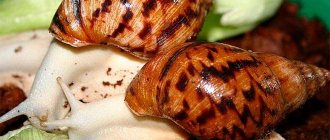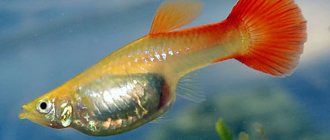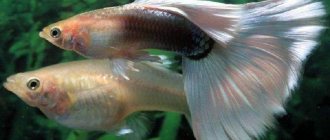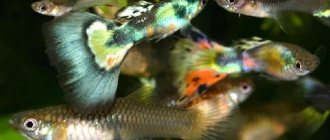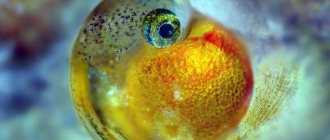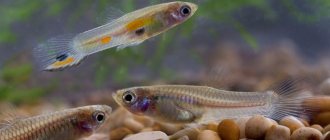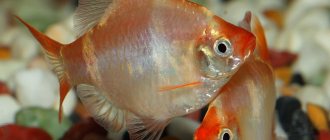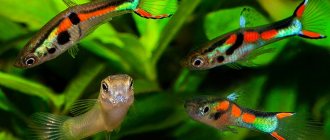Guppies are a true decoration of any aquarium; they are almost the most popular fish among aquarists. Selectively bred varieties of guppies are descendants of tropical fish from South and Central America. These are immigrants from Venezuela and Trinidat. Therefore, the temperature in the aquarium, for the normal functioning of guppies, must be tropical, at least 25 degrees, but even a little lower will not be critical for them. This subspecies of the Poeciliidae family, of which there are more than 170 species, is freshwater and viviparous. Guppy breeds and their names, like a flower meadow, have collected all the colors of the rainbow: carnation, blue grass, scarlet, orange guppy, green and blue guppies and many others.
The domestic fish we see in aquariums are very different from their “wild” relatives. This happened thanks to many years of work by breeders. Today there are more than 13 of them. But today there is no accurate and clear classification of guppies’ species and breeds. Everything is quite blurry and uncertain. But first, a few words about keeping fish.
Caring for regular guppies
Simple gupeshki can be kept in an ordinary three-liter jar with a bunch of grass.
- Caring for them requires special attention; this is the first myth that fish are unpretentious and easy to care for. All species are very sensitive to changes in water parameters and other vital indicators, water hardness, frequency of water replacement, temperature, lighting, quality and quantity of feed, the existence of an aerator, ambient temperature.
- The least demanding to care for are guppies with a grayish-brown body background, both females and males. The next most whimsical ones are light subspecies, then dark, black, glossy and albinos.
- If you are planning to breed purebred guppies, then you will be forced to keep different species, their females and males in a separate place; the notorious three-liter jar is suitable for this.
- Before giving birth, the female will have a noticeable “spot of maturity” near the anus, which means the need has come to place her in the “maternity ward ,” a separate aquarium or jar.
- After giving birth, the female is separated and the fry are left to grow away from their parents. If you do not have the opportunity to maintain an additional reservoir, then you can create a shelter for the fry in a common aquarium with thickets of algae. Otherwise, the fry will be eaten by adult fish as food.
- For the normal development of fry, a 5 liter jar is enough. To feed them, place elodea and water cabbage in it.
- Female guppies usually give birth to fry before they are three years old. If well maintained, they live for about four years. But the longevity of males is limited to three years.
How to determine the sex of guppy fry
From the very first day that a female guppy gives birth to babies, many aquarium owners wonder when and how to distinguish female guppy fry from males. After all, guppies are viviparous fish and they give birth to already formed fry that are ready for independent life. With proper care, they grow quickly and already at the age of 2 weeks you can try to determine the sex of guppies in fry. If you can discern a dark stripe under the fish's belly, it will be a female. This is how she develops a “pregnancy spot”. Males do not have such a spot.
For those who have professionally decided to start breeding guppy fish, this information is quite important, since it is necessary to carry out jigging on time, and if this is not done, then there may be such troubles as earlier fertilization of females, which will lead to defective pregnancy or death of fry, and this is not in interests of any aquarist.
It is also necessary to know that puberty of males occurs at 4-5 weeks of their life, which means that by this age the color should already appear on their fins. This will help distinguish guppy fry by gender. However, this does not always happen exactly at such a time. Several factors can influence this. One of the important ones is feeding the fry. If the food is incorrectly selected or is rarely fed, the fins do not color for a long time, but remain pale. In this case, it is important to reconsider the fish’s diet and listen to advice on feeding the fish.
Caring for selective guppies and how to breed them
Selected “pedigreed” guppies are very different from ordinary ones in shape, color, and their content in the aquarium.
There are breeds of guppies that the average aquarist has never seen.
Let's start with the fact that some types of gupeshkas are generally difficult to acquire. You will not find such fish in pet stores. This is explained simply; breeding a breed requires a lot of experience, knowledge and time, sometimes it takes years. Therefore, you can only get such fish in your aquarium from breeders, and they cost a lot of money. Marriage is usually allowed within the same breed. If it is more than 15%, then it is not pure.
Every breeder is proud and protects his new breeds of guppies. Considering that this is his merit and exclusiveness, therefore, they usually sell purebred males without females on the market, thinking that the buyer will never be able to breed something like that. This is a hoax, another myth about beautiful tropical fish.
In order to repeat the breed, you need to cross a purebred virgin female of the appropriate color with the strongest male. Raise the baby girl to the required age, and cross the “father with his “daughter”. Then, already in the second generation, “native” purebred females will appear. The coloring of the father’s breed will be repeated only in the son.
Where to buy and how much do they cost?
Buying these fish is not problematic; just visit a pet store or market, where there are enough private establishments. At this stage, it is very important to know that the ratio of females to males should be in the proportion of 2 to 1, that is, two females for one male.
Prices for aquarium fish Guppy depend on the breed group, age and size. Their cost ranges from 90 to 110 rubles per piece. It should be noted that even the rarest specimens are affordable for any aquarist.
Step-by-step program for breeding purebred fish
Purebred fry are very picky about the temperature in the aquarium.
- We place a female and a male in an aquarium (with a volume of at least 20 liters) with a filter and heating.
- Once you receive the litter in a month, begin selecting the best fry.
- Keep the fry at a temperature not lower than 25 degrees , change the water every two days, and abundant feeding is necessary.
- Sex differences are visible after 3 weeks. In males, the reproductive organ, the anal fin, gradually becomes triangular in shape with a pointed point.
- Select the fry. Choose the most developed females, distinguished from others by their large abdomen and size.
- The maintenance of different “families” from the breed should be kept separately. Based on the litters, the breed is selected from the female and filtered.
- Females need to be provided with temporary rest from males in a separate aquarium. Males of different breeds can be kept in one place.
- Adult guppies must be fed in a balanced manner. This is a fish that feeds on vegetation, but it also needs other food: microfeed, dry spirulina, vitamins, brine shrimp.
Breeds such as “Red Moscow”, “Moscow Blue-Green”, “Moscow Blue”, royal guppies, veil guppies, carpet guppies and others are extremely rare among collectors.
These are just some aspects of the knowledge that is necessary when breeding new breeds, when preserving and continuing species. The most exciting activity of guppy selection will require you to have knowledge based on personal experience and a lot of patience and time.
Classification by body pattern
Classification of Guppy by body pattern
Illustration of the differences in body pattern between the crown varieties of Guppy fish: Tuxedo (tuxedo), Cobra (cobra), Snakeskin (snake skin)
Tuxedo (tuxedo) - the front part of the body is lighter than the back. The contrast is most pronounced in black and white varieties, reminiscent of a tuxedo in color.
Cobra (cobra) - there are vertical stripes and specks on the body, the shade of which differs from the main color.
Snakeskin (snake skin) - the body is decorated with a pattern of numerous rosettes, turning into one another. Colors may include gold, black and orange patterns.
Some purebred types
There is no general worldwide classification of guppy breeds. Most species differ in the shape of the tail, fins and color. For example, in East Asia, fish of the same color are classified as “Dragon”, in the United States as “Snakeskin Guppy”, etc.
Consider the classification by color
The color or color of a fish consists of three indicators: the color of the “skin”, the color of the scales, and the color of the plaque on the scales. It is in the combination of all the integuments that their color is formed. This combination is complemented by cell pigment. For example, the group of red-tailed breeds includes: Berliner guppies, red blond guppies. These fish are of the same breed, but within it there are different colors. This also includes blue and green guppies. Among them there are mixed, unstable breeds, such as Prussian, leopard, scarlet guppies. In other words, they look at the active or dominant color, which is the definition of the breed by color. They also distinguish: malachite guppies and yellow guppies. But at the same time, this is the most subjective classification.
And yet, the following types are distinguished:
Moscow
Moscow. Has a green, purple or blue uniform metallic tint.
Tuxedo
Tuxedo guppy. Translated as “tuxedo”, the fish is, as it were, “dressed” with the back half of its body in a dark color.
Spaniards
Spanish guppies. The main body color is semi-black, the tail is yellow with a red edge and a small black pattern.
Panda
Guppy panda. The fish has half its body white, the back half of its body and tail black.
Neon
Neon guppies have a variety of shades of pearl, from the mouth itself to the fin on the back. This group also includes green and neon blue guppies.
Carpet
His tail is covered with a “mosaic”.
Leopard
Guppies are leopard-skinned and have the appropriate coloration, like the skin of a leopard.
Blond
The fish has light pigmentation throughout its body.
Glass
Glassy in appearance, lacks pigment and has red eyes.
Galaxy
A motley fish with a mosaic color.
Savage
The color is gray with multi-colored spots.
Carnation
Has an orange tail with a black pattern.
Japanese
The body of the fish is semi-black, but the fins can be of any light shade.
Berlin
A fairly well-known species with a semi-black body and red fins.
Martin
All the fins of this fish are very elongated.
Guppy Sunset
Translated as “sunset”, which is reflected in their color.
Red Moscow
As you can see in the photo, the fish is completely red.
Germanic
German guppies are predominantly yellow in color.
All types of guppy mix have different colors and shapes. They are obtained by crossing different species. Jokingly, they were given the name “nobles.” The peculiarity of the species is that the females are quite large. They can reach a length of up to 6 centimeters. Males are smaller, up to 3 cm in length. When producing offspring, males can be variegated and have all shades, from red to purple. Emerald green and neon spots may be present on the body. This is a real miracle of nature, and the result of the hard work of breeders. Today there are eight main color options for these fish.
Classification according to the shape of the tail and fins
Based on the size and shape of the fins and tail, there are several main varieties of guppies. Veiled guppies have a bushy tail. Let's look at their main subspecies:
Fantails
Fan-tailed (acute-angled). Lush tail and long flowing dorsal fin.
Fork
The tail is like a fork, separated into two sharp ends.
Flagtails
Accordingly, it has the shape of a rectangle, a flag. The fin on the back is pointed.
Spinetails
They have a round tail. In the middle its rays are elongated. The fin on the back rises sharply.
Speartails
The tail fin is like the tip of a spear. The fin on the back is curved
Triangel
The tail is shaped like a slightly open fan or an isosceles triangle. The dorsal fin is wide and raised upward.
Round-tailed
Rounded caudal fin. The dorsal fin is also rounded.
Double sword
The shape of the tail is oval, the rays are long towards the bottom. Narrow dorsal fin.
Lyrebirds
The tail is in the shape of a lyre, the fin is raised on the back.
Lower sword
The caudal fin is oval, but the lower sword-shaped rays are elongated. On the back, the fin is narrow and straight, and the end is also sharp.
Upper sword
Here, on the contrary, the upper ray of the oval tail is elongated, and the dorsal fin has the same shape.
Classification by tail shape
Probably the only generally accepted classification of Guppies, which can be found among breeders around the world. It developed in the early 2000s and includes 12 varieties.
Classification of Guppy by tail shape
Illustration of twelve varieties of Guppies, differing in tail shape.
In 2015, the international competition 1st Intercontinental Guppy Championship was held in Dortmund at the Aqua EXPO Tage, where four new varieties of guppies with previously unknown forms of the caudal fin were presented: “crescent”, “ribbon”, "swallow" and "crown".
Since then, there have been proposals to expand the classification to 16 varieties, and they can already be found in some sources.
Classification of species
To date, aquarists have studied a large number of species and breeds of this popular fish. At the same time, breeders never cease to amaze with the variety of new groups of guppies that have been bred. This aquarium pet has long become a regular at international exhibitions and competitions, thanks to its many shapes and colors. Modern species of guppies include more than a hundred breeds and breeding groups of representatives of the Peciliaceae. Fish are classified by color and type of caudal fin. Also, the natural forms of these fish are classified into a separate group.
Where do guppies live?
This miniature fish is native to South America. They live in bodies of water throughout the continent and on the islands of the Caribbean. The endurance and unpretentiousness of small guppies allowed them to settle in almost all types of water bodies in this territory: swamps, lakes and rivers. There is information that schools of fish have been spotted at the mouths of rivers at the junction of fresh and salt water.
Guppies were first discovered in northern South America.
These heat-loving fish most often live in reservoirs with weak currents. The fish live in groups of an average of 10 individuals. They live in areas with dense vegetation so that in case of a dangerous situation they can hide there from attack. For safety reasons, guppies swim mainly only on the surface of the water.
The fish are often acclimatized and placed in various freshwater bodies. These activities are carried out throughout the world to combat malaria vectors . Guppies do an excellent job of this task, thereby doing the world community a great favor.
Compatibility of different types of guppies in one aquarium
Guppies are very friendly creatures and don't mind being around them. They are not picky and are quite ready to live in the conditions required by their aquarium partners.
The guppy compatibility chart will help you choose neighbors for any type of guppies, including baby Endlers.
The best company for them can be found in aquarium inhabitants of a similar size to them: neons, tetras and zebrafish. As for representatives of another classification of guppies, you need to be careful here. The fish most likely will not be able to harm each other, but as a result of crossing, not entirely normal offspring may be obtained. It is best to have several aquariums when breeding different types of guppies.
Natural types of guppies
There are 3 main types of in nature .
Ordinary
This is the most common species of guppy in the world from which all other morphs originate. It’s not for nothing that more than 60 breeds of these miniature fish have been identified. The appearance of this variety of guppies is much simpler than that of their purebred counterparts. The fish, about 3-6 cm in size (depending on gender), has a slightly rounded tail and multi-colored spots on the body.
Endler
These fish are even more modest in size. The maximum length of the male is only 2.5 cm. The size of his partner can reach 3.5 centimeters. Females look discreet, while male Endler guppies are full of yellowish, purple, green and black colors.
Micropecilium
The Swamp Pict (Micropecilius) is a larger variety of guppy that is extremely rare . The size of this fish can reach 5 cm. Females are inconspicuous, and males are not deprived of bright external characteristics. There are many color options: from gray to bright orange. Their mouth has a sharper shape, and some of them are characterized by bright stripes on the side.

